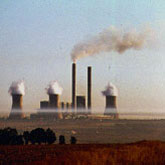What is Haze?
 Haze is caused when sunlight encounters tiny pollution particles in the air. Some light is absorbed by particles. Other light is scattered away before it reaches an observer. More pollutants mean more absorption and scattering of light, which reduce the clarity and color of what we see. Some types of particles such as sulfates, scatter more light, particularly during humid conditions.
Haze is caused when sunlight encounters tiny pollution particles in the air. Some light is absorbed by particles. Other light is scattered away before it reaches an observer. More pollutants mean more absorption and scattering of light, which reduce the clarity and color of what we see. Some types of particles such as sulfates, scatter more light, particularly during humid conditions.
Air pollutants come from a variety of natural and manmade sources. Natural sources can include windblown dust, and soot from wildfires. Manmade sources can include motor vehicles, electric utility and industrial fuel burning, and manufacturing operations. Some haze-causing particles are directly emitted to the air. Others are formed when gases emitted to the air form particles as they are carried many miles from the source of the pollutants.
Some of the pollutants which form haze have also been linked to serious health problems and environmental damage. Exposure to very small particles in the air have been linked with increased respiratory illness, decreased lung function, and even premature death. In addition, particles such as nitrates and sulfates contribute to acid rain formation which makes lakes, rivers, and streams unsuitable for many fish, and erodes buildings, historical monuments, and paint on cars.
About the Author
EPA US Environmental Protection Agency
 The Environmental Protection Agency is an independent executive agency of the United States federal government tasked with environmental protection matters.
The Environmental Protection Agency is an independent executive agency of the United States federal government tasked with environmental protection matters.


